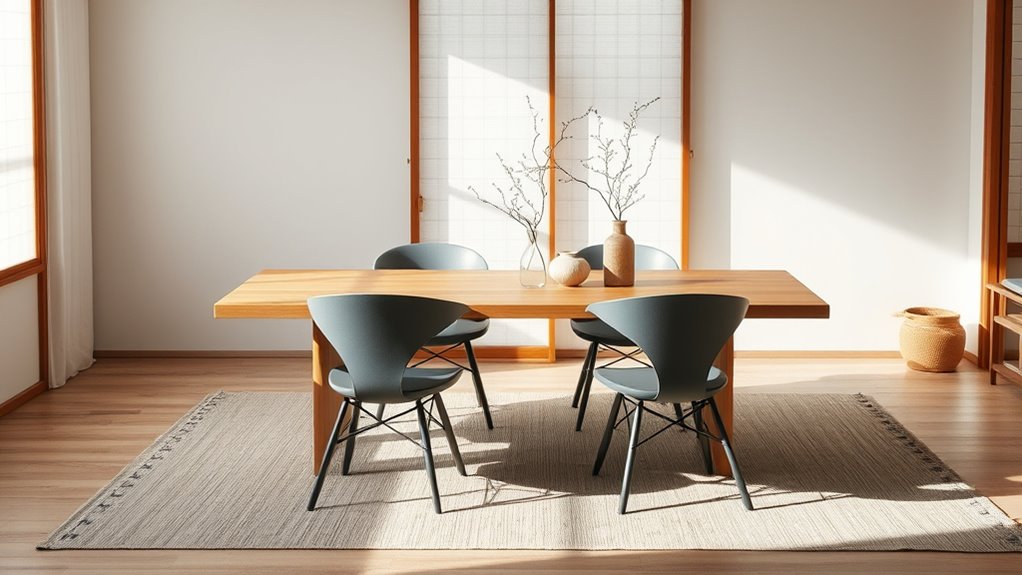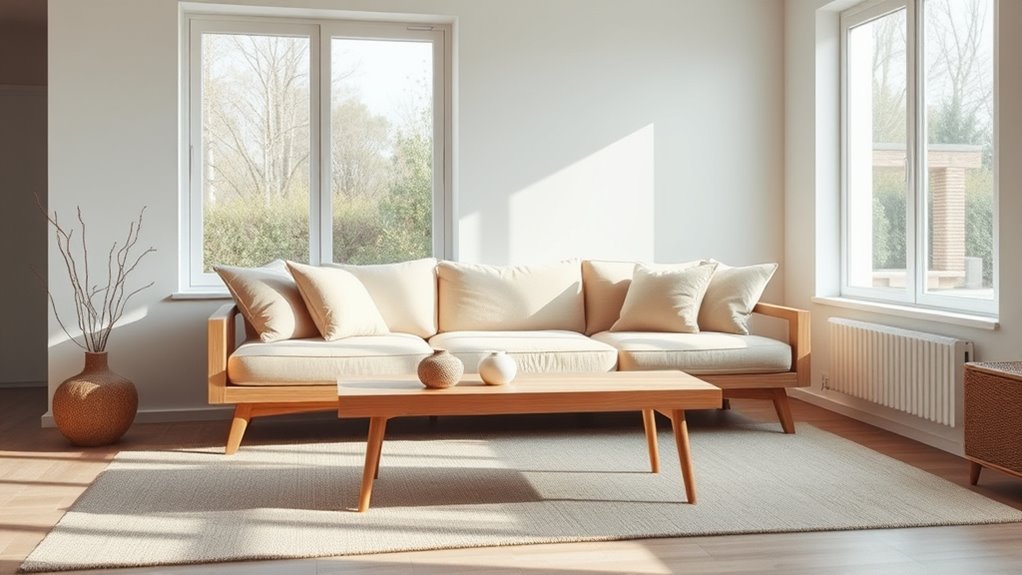Japandi style blends Japanese minimalism with Scandinavian coziness to create calm, stylish, and functional spaces. You’ll focus on simple, authentic designs using eco-friendly materials like reclaimed wood, organic textiles, and handcrafted pieces. Soft, diffused lighting enhances tranquility, while a neutral palette of beige, gray, and white emphasizes natural textures. Balancing these elements builds a peaceful environment that promotes mindfulness and comfort. If you keep exploring, you’ll discover how to fully embrace this harmonious design approach.
Key Takeaways
- Combines Japanese minimalist elegance with Scandinavian cozy charm to create calm, stylish, and functional spaces.
- Emphasizes natural, sustainable materials like reclaimed wood, organic textiles, and handcrafted decor.
- Uses soft, layered lighting and neutral earthy tones to foster tranquility and warmth.
- Prioritizes simplicity, authenticity, and quality craftsmanship for a balanced environment.
- Focuses on minimalism and natural textures to promote mindfulness and a serene atmosphere.

Have you ever wondered how to create a space that feels both calm and stylish? If so, embracing Japandi style might be just what you need. This design philosophy seamlessly blends the minimalist elegance of Japanese aesthetics with the cozy, functional charm of Scandinavian decor. The key to achieving this look lies in your choices of sustainable materials and lighting techniques, which work together to foster tranquility and simplicity.
When selecting sustainable materials, focus on natural, eco-friendly options that promote a sense of harmony with the environment. Think about using reclaimed wood for furniture, organic cotton or linen for textiles, and bamboo or cork for flooring. These materials not only look beautiful but also reduce your ecological footprint. Incorporate elements that emphasize craftsmanship and authenticity, such as handwoven baskets or ceramic vases, which add texture and warmth to your space. The idea is to prioritize quality over quantity, creating a serene environment that feels both intentional and inviting. Incorporating handcrafted elements can further enhance the authenticity and warmth characteristic of Japandi design.
Choose natural, eco-friendly materials like reclaimed wood, organic textiles, and bamboo to create a warm, harmonious, and sustainable space.
Lighting techniques play a *pivotal* role in enhancing the Japandi aesthetic. Aim for soft, diffused lighting that mimics natural daylight to create a calming atmosphere. Use layered lighting—combine ambient, task, and accent lights—to add depth and interest without overwhelming the space. For example, place a sleek floor lamp with a fabric shade near a reading nook or install minimalist wall sconces that emit a gentle glow. Avoid harsh, bright lights; instead, opt for warm-toned bulbs that evoke a cozy, welcoming ambiance. Incorporate natural light as much as possible by keeping window treatments light and minimal, allowing sunlight to filter through and highlight the natural textures of your sustainable materials.
The interplay between sustainable materials and thoughtful lighting techniques helps to establish a balanced environment that embodies the Japandi ethos. It’s about creating a space that promotes mindfulness and relaxation while maintaining a clean, uncluttered look. Every element should serve a purpose, whether it’s a handcrafted wooden table or a softly lit corner for meditation. Keep your color palette neutral and earthy, with muted shades like beige, gray, and soft whites, to further reinforce that sense of calm. Minimalism doesn’t mean sacrificing comfort; it’s about carefully curating each piece and light source to craft a space that feels harmonious, intentional, and truly your own.
Frequently Asked Questions
How Can I Incorporate Natural Materials Into Japandi Decor?
You can incorporate natural materials into your Japandi decor by choosing sustainable options like bamboo, reclaimed wood, and cork. Use these materials for furniture, such as low tables or shelves, and add organic textures with linen or wool textiles. Incorporate stone or clay accents for a tactile feel. This blend of sustainable materials and organic textures enhances the minimalist aesthetic, creating a warm, inviting space that balances simplicity and nature seamlessly.
What Color Palettes Are Best for a Calming Japandi Space?
Ever wonder what color palette creates a calming Japandi space? Opt for soothing shades like soft neutrals, muted earth tones, and gentle grays to achieve perfect color harmony. These hues promote tranquility and simplicity, essential to Japandi design. Keep the palette minimal and cohesive, emphasizing understated elegance. Do you see how these calming shades help you create a serene environment that balances Japanese minimalism with Scandinavian warmth?
How Do I Balance Functionality and Aesthetics in Japandi Design?
To balance functionality and aesthetics in Japandi design, prioritize minimalist storage solutions that keep clutter out of sight, ensuring clean, simple lines. Incorporate decorative accents sparingly to add personality without overwhelming the space. You should choose furniture that combines form and function, emphasizing quality over quantity. This way, your space remains serene and practical, reflecting Japandi’s harmony between minimalism and beauty.
Are There Specific Furniture Styles Unique to Japandi?
You’ll find that Japandi features specific furniture styles combining Scandinavian furniture’s clean lines and functionality with Japanese woodwork’s intricate craftsmanship. Think low-profile, minimalist pieces with natural wood finishes, simple forms, and subtle details. You might choose a sleek, Scandinavian-inspired sofa paired with a handcrafted Japanese wooden coffee table. This blend creates a harmonious balance, emphasizing both practicality and beauty, characteristic of the Japandi aesthetic.
How Can I Personalize Japandi Interiors Without Cluttering?
You can personalize your Japandi interiors by adding meaningful decorative accessories, like handcrafted ceramics or textured textiles, to reflect your style. Incorporate statement art with clean lines and subtle colors to create focal points without clutter. Keep surfaces clear and choose a few carefully curated pieces to maintain the minimalist aesthetic. This approach enhances your space’s warmth and personality while staying true to Japandi’s harmony and simplicity.
Conclusion
Embracing Japandi style allows you to create a space that’s both serene and functional. Its blend of Japanese minimalism and Scandinavian coziness offers a balanced escape from clutter, promoting tranquility. Did you know that homes adopting minimalist designs like Japandi tend to report 30% less stress? By choosing this style, you’re not just enhancing your decor—you’re fostering a peaceful environment that boosts your well-being every day.









